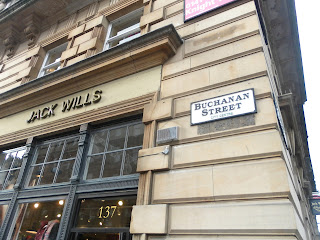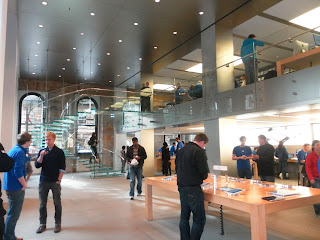After visiting our local Peacocks store in Dundee, we soon realised that their website does not resemble their store, in any way, whatsoever. We identified this as a major problem.
The connotations of the website are classy, fresh and professional. Unfortunately these connotations do not transpire within the interior space of the store.
The current interior of Peacocks looks disjointed and unorganised. When visiting the store we found that a number of different sub brands existed. These included: 'urban style', 'e-vie', 'closer with e-vie' and 'peacocks by design'. We were fortunate enough to get talking to the store manager who was able to tell us that Peacocks were about to get rid of the sub brand 'e-vie' and substitute it with a new sub brand called 'Peacocks with style'. We thought this sounded like a good idea considering they varied between fonts with the 'e-vie' brand. We weren't impressed with the inconsistency.

When we were talking to the store manager I made a point in asking about the exclusive 'Pearl Lowe' range that (according to the website) can be found in Peacocks stores. She told us that Pearl Lowe clothing lines didn't exist in any of the Scottish Peacocks stores. We found this disappointing. She said the clothing lines only existed in about 25 selected stores in England, such as in the Metro Centre, Newcastle. As the lines are exclusive, stores only receive each garment in a few sizes. When the items are sold they are not restocked. I guess this is what makes the clothing line 'exclusive' but I don't feel like this benefits the business.
The store manager also mentioned that a lot of women would come into the store and ask to be directed to the Pearl Lowe clothing range. When they are told that the store doesn't stock anything from the Pearl Lowe range, customers leave feeling disappointed. This can unfortunately give customers a negative perception of the store.
Through observation, it's obvious that the entire store is completely mixed up. The ladies section merges directly into the young girls section, with no obvious boundary. The same goes for the everyday clothes and the evening wear -everything is merged together. If I'm honest, not all is bad. Some of the clothes are actually quite nice, however this is not noticeable because they are displayed within and beside unfashionable/poorer quality clothes.
The photography within the store is really nice, however the clothes that the models are wearing are either well hidden within the store or they are not even available to buy in the store. This is not going to successfully sell items.
I honestly believe that Peacocks have potential. This is achievable with a fresh start. First things first, we need to differentiate their strengths from their weaknesses...


















































